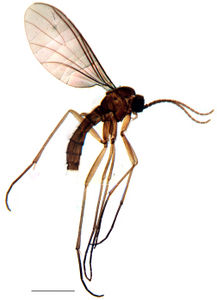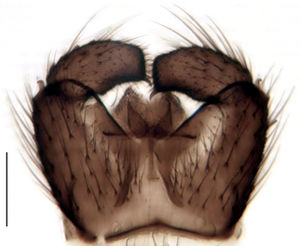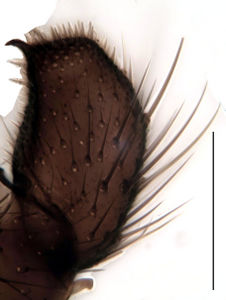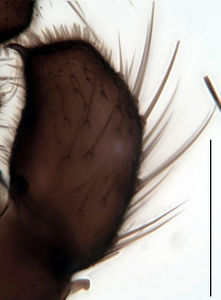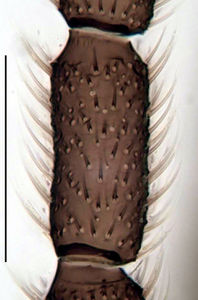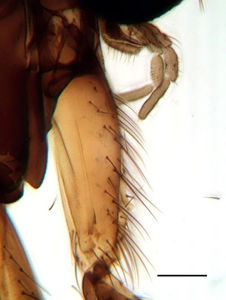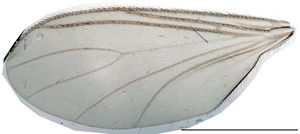Trichosiopsis echinata
Ordo: Diptera
Familia: Sciaridae
Genus: Leptosciarella
Name
Leptosciarella echinata (Lengersdorf, 1926) restit., comb. n. – Wikispecies link
- Sciara echinata Lengersdorf, 1926[1]: 126, fig. 5
- Leptosciarella (Leptosciarella) echinata (Lengersdorf, 1926)
Type material
Holotype: ♂, 15.08.1893, leg. Mik in NHMW
Type locality
Austria, Hainfeld
Material studied
Austria: 1 ♂, Styria, Gesäuse National Park, Hartelsgraben, Handhabenhöhlenquelle, Gerecke, 05.07.2008, PKHH 7112 [as Leptosciarella rejecta (part.) in Heller (2012[2])]; Denmark: 1 ♂, Sonderhav, old beech forest, sweep netting, Heller, 22.05.2010, PKHH 7590; Finland: 1 ♂, Ou, Hiidenportti N.P., Uroporvaara: spruce/birch/aspen forest, sweep netting, Jaschhof, 10.07.2004, PKHH 6453; 3 ♂, 11.07.2004, PKHH 6298, MZH 9039; 2 ♂, Ab, Karjalohja, Karkaliniemi, Stahls, 02.07.2007, MZH 9215/9216; 1 ♂, Kb, Pratvinsuo N. P., Autiovaara: spruce/birch/aspen forest, sweep netting, Jaschhof, 07.07.2004, PKHH 6305; 1 ♂, Lk, Yllästunturi, Kolari, Mannikko, Yakovlev & Penttinen, no date, MZH 9217; Germany: 2 ♂, Baden-Württemberg, Malsch, Wolfsgrube, Feuchtbrache, Malaise trap, Doczkal, 30.-31.05.2011, PKHH 8085; ZSMC 3789 (DNA barcoding); 1 ♂, Mössingen, Hirschkopf, Quelle Hi 3, Buchenwald westlich des Bergrutschs, sweep netting, Gerecke & Bückle, 09.05.2011, PKHH 7924; 1 ♂, Schelingen, Buchenwald, sweep netting, Heller, 28.05.2011, PKHH 7845; 1 ♂, Mecklenburg-Vorpommern, Greifswald, deciduous forest, Malaise trap, Jaschhof, 1994, PKHH 5448; 1 ♂, Elisenhain, beech forest, Jaschhof, 10.05.1993, PWMP 4039; 01.06.1984, Mohrig, PWMP 1625 [as Leptosciarella rejecta in Mohrig & Menzel (1997[3]: 63)]; 2 ♂, NSG Galenbecker See, Grünland Rasenschmielen-, Quecken-, Kohldistel-, Staudenflora, photoeclector, Jaschhof, 29.8.-10.10.1994, PWMP 1648/4038; 2 ♂, North-Rhine-Westphalia, Ubbedissen, beech forest, sweep netting, Heller, 12.06.2004, PKHH 4209; 1 ♂, Rhineland-Palatine, Eifel, Gönnersdorf, Mäuerchenberg, dry grassland, Malaise trap, Cölln, 1.-08.06.1991, PKHH 1879 [as Leptosciarella scutellata (part.) in Heller (1999[4]: 256)]; 1 ♂, Saxony-Anhalt, Rübeland, Blauer See, Mischwald aus Fichte und Bergahorn, sweep netting, Heller, 09.06.2001, PKHH 3422 [as Leptosciarella rejecta in Menzel et al. (2002[5]: 184)]; 1 ♂, Schleswig-Holstein, Sterley, beech forest, sweep netting, Heller, 17.05.2003, PKHH 3982; 2 ♂, Thuringia, Hainich Nationalpark, Craulaer Kreuz, beech forest, sweep netting, Heller, 18.06.2005, PKHH 4398/4402 [as Leptosciarella rejecta in Menzel & Heller (2006[6]: 55)]; 1 ♂, Rabis near Jena, sweep netting, Jaschhof, 26.06.1993, PWMP 4040/4041; 1 ♂, mixed forest at Thiemsburg, sweep netting, Heller, 18.06.2005, PKHH 4358 [as Leptosciarella rejecta (part.) in Menzel & Heller (2006[6]: 55)]; 1 ♂, NSG Sonder b. Schlotheim, Hanfsee, Kesselmoor (Birke), Menzel, 28.05.1988, PWMP 1628 [as Leptosciarella rejecta in Mohrig & Menzel (1997[3]: 63)]; Hungary: 1 ♂, Aggtelek, Nemzeti Park, sweep netting, Rulik, 23.-25.05.1998, PWMP 1637 [as Le. rejecta in Rulik et al. (2001[7]: 241)]; Latvia: 1 ♂, Kauguri, Spungis, 06.06.1981, PWMP 1645 [as Leptosciarella rejecta in Mohrig & Menzel (1997[3]: 63)]; 2 ♂, Sigulda, Spungis, 10.06.1978, PWMP 1646/1647; Russia: 1 ♂, Altay Region, Artybash, forest, sweep netting, Heller, 03.07.2005, PKHH 4434; Sweden: 1 ♂, Skåne, Simrishamn, Stenshuvud National Park: Svabeholmsskog, hornbeam forest, Malaise trap, Swedish Malaise Trap Project, 22.5.-20.06.2005, PKHH 7238; 1 ♂, 20.-26.06.2005, PKHH 6665/6667; 1 ♂, Södermannland, Södertälje, Tullgarns näs, Rävsalaviken, mixed forest next to pasture, Malaise trap, Swedish Malaise Trap Project, 3.7.-19.08.2004, PKHH 7485; 1 ♂, 16.6.-17.07.2005, PKHH 7405; 1 ♂, Torne lappmark, Nikkaluokta, Norrbottens län, young birch/willow forest along stream, Malaise trap, Jaschhof & Jaschhof, 14.7.-05.08.2005, PKHH 5942/5943, NHRS 1076-1078 [as Leptosciarella scutellata in Heller et al. (2006[8]: 41)]; 1 ♂, Västerbotten, Skellefteå, Brännbergets naturreservat, mixed boreal forest, Malaise trap, Swedish Malaise Trap Project, 21.7.-12.08.2004, PKHH 7294: Turkey: 1 ♂, Sürcüler, Isparta, Koc, Karman & Özgül, 15.05.2004, PKHH 4325. .
Description (male)
Head. Eye bridge 4–5 rows of facets. LW-index of 4th antennal flagellar segment 1.9–2.4; neck 0.28–3.4 of segment width; Transition of basal part to neck pronounced. Colour of neck unicolour. Antennal hairs shorter than segment width; sparse; adjacent, or salient. Palps darkened; normal; palpomeres 3. First palpomere of normal shape or thickened; with 5–8 bristles; with only some sparse sensillae. Second palpomere shortly oval. Third palpomere as long as first segment. Thorax. Colour brown. Notum unicolorous. Thoracic setae normal; dark. Mesonotum with some weaker central bristles. Posterior pronotum setose. Postpronotal setae 2–5. Laterotergite bare. Legs. Colour yellow-brown. Hind coxae darkened. Hairs on fore coxae black. Front tibia apically with a patch of setae. Front tibial organ dark. Front tibial organ not bordered. Tibial setae on hind legs normal, shorter than tibial width. Tibial spurs of equal length. Claws untoothed. Wings. Wings slightly darkened; of normal shape. Wing membrane without macrotrichia. Wing venation weak, with faint m-base. M-fork of normal shape. R1 inserting at or slightly before base of m-fork; posterior veins with macrotrichia; stM mainly with macrotrichia; cuA1 and cuA2 mainly with macrotrichia; bM bare; r-m with a few setae; bM:r-M 1.05–1.3; st-Cu:bM 0.3–0.45; r1:r 1.7–1.95; C:w 0.6–0.75. Halteres dark; of normal length. Abdomen. Abdominal setae strong and dense; dorsally dark; ventrally dark. Hypopygium concolour with abdomen; 0.6–0.75 × longer than wide. Base of gonocoxites with strong setae; gonocoxites broadly separated; inner margin of gonocoxites normally U-shaped; inner part of hypopygium scarcely setose; elongated setae on valves of hypopygium absent. Gonostylus elongate; 1.8–2.1 × longer than wide; Inner margin straight, or concave; apex with one obtuse angle, or nearly rectangular. Apical tooth present; 2.1–2.6 × longer than broad; strong. Awl-like setae normal; below apex present. Megasetae on inner part of gonostylus absent. Whiplash-hair absent. Tegmen 0.65–0.8 × longer than broad; rectangular with rounded edges; normal; Central process absent. Length of aedeagus/hypopygium 25–35 %; Aeadeagal apical structure absent. Measurements. Body size 2.7–3.2 mm. Hind tibia 1.45–1.6 mm. Wing length 2.5–3 mm.
Diagnosis
Leptosciarella echinata is most similar to Leptosciarella rejecta. It can be distinguished by its smaller size, the shorter palpi and the darker legs with strong and dark bristles on the fore coxae. The gonostylus is usually shorter than in Le. rejecta and the bristles at the base of the gonocoxites are stronger. Otherwise Le. echinata also resembles Leptosciarella defecta, from which it differs by the darker legs, the shorter palpi and the clearly angulate and more parallel gonostyles. The species comprises at least two different forms, which are represented by fig. 2 and 3. The variant form in fig. 3 shows transitions to Leptosciarella scutellata, but differs from it by the gonostyles having a more roundish and not strictly rectangular apex and by the usually darker legs.
Discussion
The taxonomy and nomenclature of this species is not yet resolved. Leptosciarella echinata was originally described from a deformed specimen from Austria (Mohrig & Menzel, 1997[9]: 64-65). They had studied the type and synonymized Sciara echinata with Le. rejecta, which is now divided into two different species. In the original description Lengersdorf mentions the legs of Sciara echinata as being dirty-yellow, whereas in Le. rejecta they are usually shiningly yellow. Therefore provisionally the name echinata is used for this species, although it is not clear, whether the type specimen really belongs here. It is not even clear, if the species in the current sense is well defined. The studied material is still very heterogeneous and shows transitions to different other species, such as Le. rejecta, Le. scutellata and Le. defecta.
Etymology
Echinus lat. = sea urchin, making reference to the spiny apex of the gonostyles.
Ecology
Leptosciarella echinata is a common and widespread forest species.
Distribution
Austria[1], Denmark, Finland, Germany, Hungary, Latvia, Russia, Sweden, Turkey
Images
|
References
- ↑ 1.0 1.1 Lengersdorf, F. 1926: Die Sciariden des Naturhistorischen Museums in Wien. Konowia, 5(2), 122–129. PDF
- ↑ Heller, K. 2012: IV 6.3 Familie Sciaridae (Trauermücken). In: R. Gerecke, H. Haseke, J. Klauber, & A. Maringer (Hrsg.), Quellen, Schriften des Nationalparks Gesäuse 7. Weng im Gesäuse. 189–199, 373–381.
- ↑ 3.0 3.1 3.2 Mohrig, W.; Menzel, F. 1997: Revision der paläarktischen Arten von Trichosia Winnertz sensu Tuomikoski, 1960 (Diptera, Sciaridae). – Teil II. Gattungen Leptosciarella Tuomikoski, 1960 und Trichodapus gen. nov. Studia dipterologica, 4(1), 41–98.
- ↑ Heller, K. 1999: Trauermücken (Diptera: Sciaridae) von Gönnersdorf (Kr. Daun). Beiträge zur Insektenfauna der Eifeldorfer 20. Dendrocopos, 26, 249-262.
- ↑ Menzel, F.; Heller, K.; Smith, J.E. 2002: Neue Trauermücken-Nachweise (Diptera: Sciaridae) aus dem Harz nebst der Beschreibung einer neuen Bradysia-Art. Studia dipterologica, 9, 179-189.
- ↑ 6.0 6.1 Menzel, F.; Heller, K. 2006: Trauermücken (Diptera: Sciaridae) aus dem Nationalpark „Hainich“ (Thüringen) nebst der Beschreibung von Scatopsciara andrei Menzel spec. nov. Studia dipterologica, 13(1), 45–59.
- ↑ Rulik, B.; Mohrig, W.; Jaschhof, M. 2001: Trauermücken (Diptera: Sciaridae) und freilebende Gallmücken (Diptera: Cecidomyiidae: Lestremiinae) aus Ungarn. Mit Bemerkungen zur Corynoptera tridentata-Gruppe. Folia Entomologica Hungarica, 62, 231-245.
- ↑ Heller, K.; Vilkamaa, P.; Hippa, H. 2009: An annotated check list of Swedish black fungus gnats (Diptera, Sciaridae). Sahlbergia, 15(1), 23-51.
- ↑ Menzel, F.; Mohrig, W. 1997: Revision der paläarktischen Arten von Trichosia Winnertz sensu Tuomikoski, 1960 (Diptera: Sciaridae). - Teil I. Gattung 'Trichosia' Winnerz, 1867. Studia dipterologica, 4(1), 3–40.
